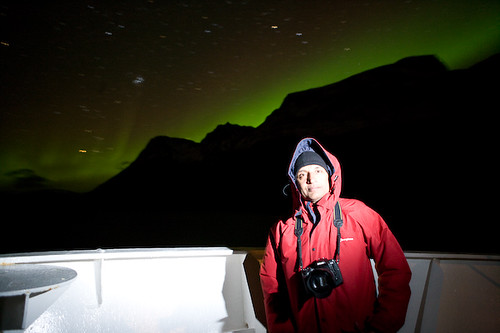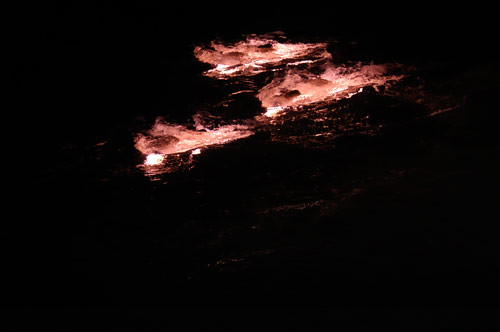
Sunand Prasad and Northern Lights as we return along Kangerlussuaq Fjord (Big Fjord).
The Greenlanders have reclaimed their place names, so the glacier shown on Danish maps as the Jakobshavn Glacier is now the Ilulissat Glacier. It is moving at 38 metres per day now sliding on more melt water and producing more icebergs than any other in the world. It would be amazing to be near enough the glacier front to hear the sound made by the calving of the icebergs. But the spot where we land by zodiacs is at the edge of a gigantic iceberg pile up caused by the terminal moraine, like a dam across the sea mouth, 50 km away now from the glacier front. The scientists have been giving us occasional classes in geology, explaining the action of glaciers, or how the salinity and temperature of the ocean contain clues to climatic behaviour.
Continue reading

During the voyage I am working on two projects. The first is to put up in a suitable and sheltered spot further north, four balloons such that a volume of 540 m3 is delineated between their tether lines: the volume of one tonne of CO2; the average emission per person per month in the UK. Within a few years we must make that same amount last 6 month.
Lun’art by Creatmosphere

Continue reading
Into the second half of the expedition the focus has moved on from assimilating masses of experience and information about the geography and culture of these parts, to what our own response to climate change might be. 46 is a lot of people to relate to but there are some interesting discussions happening at mealtimes, or in the bar or walks. Some of the musicians, like KT Tunstall, are already very conscious of their carbon footprint, reducing flying to a minimum and following a gold standard offset scheme. We don’t need an outpouring of climate change related songs and artworks; it could be embarrassing. The experience of this voyage is such a visual and sensory feast that its impressions will certainly influence people’s work, though not necessarily as climate change. Works like previous Cape Farewell expeditioner Ian McEwan’s forthcoming novel on climate change will be rare, and that is fine. What many in this crew have is access to a huge global audience that they are able to inspire. They are in a strong position to communicate not only the urgency of the condition we are in but also the huge scope for action that almost everyone in the world has, both collectively and individually.
Continue reading
Perdlerfiup Kangerdlua is a remote fjord at about 710 North and two glaciers discharge into its Y shaped end. The smaller of the two has retreated about 2 kilometres recently leaving a beach with a shallow foreshore. The larger still maintains a 100 metres high 3km wide calving face to the water, beyond which we can see the land based part of the glacier perhaps 500 metes above the fjord. It’s an amazing sight but always at the back of the mind is the possibility that the glacier may calve any second, sending out a very dangerous tsunami. Such an event left 20 people injured on one of the sister ships of the Grigory Mikheev last year and we maintain a respectful distance staying at right angles to the face as far as possible.
Continue reading

Sparker unit deployed by Carol Cotterill and Dave Smith, the British Geological Survey team, to image the sea-bed using seismic technology.
Marije’s question
Dear all, I was watching this lecture by David Keith at Ted.com about geo engineering. He poses a few very interesting questions, and I was wondering what the general view on geo engineering was on the boat?
* I am aware you probably won’t be able to watch this video on the boat…
Sunand Prasad’s response
What do the Cape Farewell crew think of Geo-Engineering as a solution to climate change? Well, we haven’t all discussed it in depth, but from a few conversations its clear that we share 1: serious worry about the unintended consequences of some of the proposals that have been aired; 2: incredulous amusement about the complete lunacy of others and 3: ill temper at the thought of the promise of technological quick fixes distracting attention from tackling the cultural challenge that climate change poses.
Continue reading
Qeqertarsuaq is a settlement of 800 people on the southern tip of Disko Island. The church, Lutheran like most of inhabited Greenland, sits at the highest point in the village and the houses are scattered on the hillsides mostly on individual plots. Many are brightly painted using every colour in the spectrum contrasting with the magnificent barrenness of much of the landscape. The cemetery makes the brightest splash of colour with the graves heaped with dayglow artificial flowers. Christian missionaries from Denmark started coming to Greenland in the early 18th century and eventually displaced the shamanistic religion practiced by the inhabitants, paving the way for the establishment of Greenland as a Danish colony. Self-rule was granted in 1979 and soon there is to be a vote on independence. Ludvig Hammeken, who is studying marketing management in Copenhagen, has joined the crew as our second Inuit guide and with Karen makes a presentation on Greenland’s history and culture.
Continue reading
Kangerlussuaq means big fjord and the big fjord that runs from the airstrip to the sea is 90 miles long. Karen Filskov a native of Greenland joins us here as guide, the first time Cape Farewell has had an Inuit crew member. The Grigoriy Mikheev was built in St Petersburg as a research vessel and now runs trips to the arctic from April to September and the Antarctic from October to February. Being designed as a research vessel it is perfect for this expedition as our itinerary is built around the research programme of the four scientists.
To read more of Sunand’s post visit his blog on The Architect’s Journal website.
On the chartered plane on the way to Kangerlussuaq to meet the boat I am sitting next to the author Lemn Sissay, who writes witty and beautiful poetry amazingly quickly. He is reading poetry and I am reading my new camera manual, which sums up a few things. Then we start seeing poetry in the camera manual: focus point, focus lock, release mode, live view, auto sensitivity, aperture priority,exposure compensation, colour space, interrupt interval, white balance.
Continue reading
The polar regions hold a profound, and even primal, fascination for so many of us. In the case of the Arctic, real journeys of adventure from Lief Erikson to Parry and Fienes, and imaginary ones from Jules Verne to Philip Pullman have added layers of meaning to its magnetic attraction, so to speak. So an invitation to go there would have been the best gift ever, even without the new and ominous message coming from the arctic. For the arctic is the harbinger of what is happening to the global climate. David Buckland, who thought up and made happen the Cape Farewell expeditions, compares it to the miner’s canaries that foretold of the presence of deadly gases underground.
Continue reading






